MOD001147: Dynamics of Strategy - Netflix Strategic Audit
VerifiedAdded on 2022/08/15
|74
|12134
|17
Report
AI Summary
This report presents a comprehensive strategic audit of Netflix, a leading company in the global video streaming market. The analysis begins with an introduction to the competitive media services landscape, highlighting the increasing market growth driven by factors like internet penetration and technological advancements. The report then delves into Netflix's internal analysis, including historical developments from its inception, strategic choices, VMOST framework (Vision, Mission, Objectives, Strategy, Tactics), product portfolio, BCG matrix, and market definition. Financial and value chain analyses, along with core competencies and the McKinsey 7-S framework, are also included. The external analysis covers customer and competitor analysis, industry life cycle, and a PESTEL analysis. A strategic fit analysis, incorporating SWOT, EVR congruence, ESP, and a balanced scorecard, assesses Netflix's position. The report further explores strategic direction, trend and sensitivity analyses, and risk management. It proposes strategic options, including incorporating educational shows and obtaining secondary listings in emerging markets. The report evaluates the suitability, acceptability, and feasibility of these options. The implementation and control sections discuss alignment of company structure, project management, and green strategy. The report concludes with a business plan and execution plan, offering insights into Netflix's strategic choices and market position.

Running head: MANAGEMENT
Strategic Fit of Netflix
Name of the student
Name of the university
Author Note:
Strategic Fit of Netflix
Name of the student
Name of the university
Author Note:
Paraphrase This Document
Need a fresh take? Get an instant paraphrase of this document with our AI Paraphraser
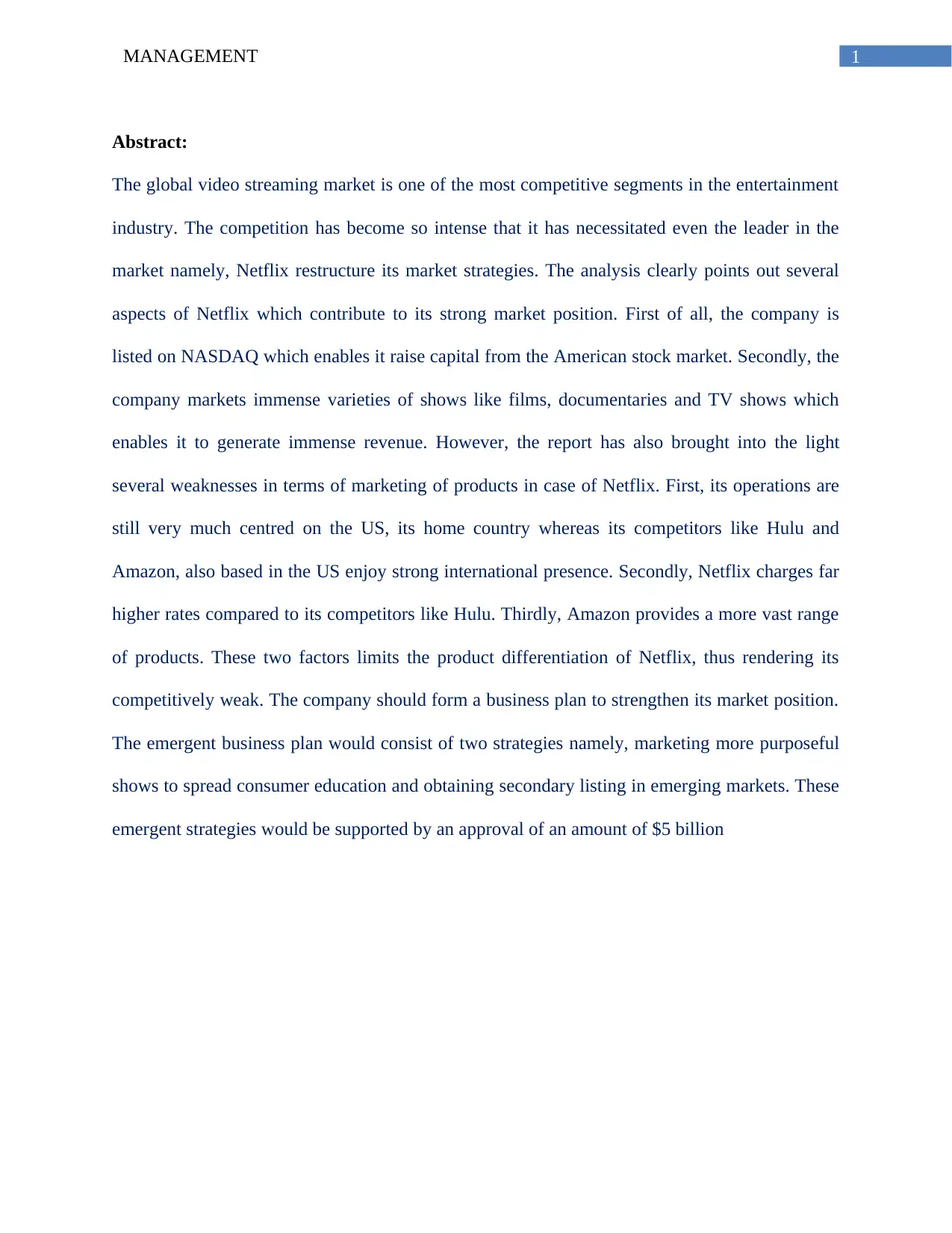
1MANAGEMENT
Abstract:
The global video streaming market is one of the most competitive segments in the entertainment
industry. The competition has become so intense that it has necessitated even the leader in the
market namely, Netflix restructure its market strategies. The analysis clearly points out several
aspects of Netflix which contribute to its strong market position. First of all, the company is
listed on NASDAQ which enables it raise capital from the American stock market. Secondly, the
company markets immense varieties of shows like films, documentaries and TV shows which
enables it to generate immense revenue. However, the report has also brought into the light
several weaknesses in terms of marketing of products in case of Netflix. First, its operations are
still very much centred on the US, its home country whereas its competitors like Hulu and
Amazon, also based in the US enjoy strong international presence. Secondly, Netflix charges far
higher rates compared to its competitors like Hulu. Thirdly, Amazon provides a more vast range
of products. These two factors limits the product differentiation of Netflix, thus rendering its
competitively weak. The company should form a business plan to strengthen its market position.
The emergent business plan would consist of two strategies namely, marketing more purposeful
shows to spread consumer education and obtaining secondary listing in emerging markets. These
emergent strategies would be supported by an approval of an amount of $5 billion
Abstract:
The global video streaming market is one of the most competitive segments in the entertainment
industry. The competition has become so intense that it has necessitated even the leader in the
market namely, Netflix restructure its market strategies. The analysis clearly points out several
aspects of Netflix which contribute to its strong market position. First of all, the company is
listed on NASDAQ which enables it raise capital from the American stock market. Secondly, the
company markets immense varieties of shows like films, documentaries and TV shows which
enables it to generate immense revenue. However, the report has also brought into the light
several weaknesses in terms of marketing of products in case of Netflix. First, its operations are
still very much centred on the US, its home country whereas its competitors like Hulu and
Amazon, also based in the US enjoy strong international presence. Secondly, Netflix charges far
higher rates compared to its competitors like Hulu. Thirdly, Amazon provides a more vast range
of products. These two factors limits the product differentiation of Netflix, thus rendering its
competitively weak. The company should form a business plan to strengthen its market position.
The emergent business plan would consist of two strategies namely, marketing more purposeful
shows to spread consumer education and obtaining secondary listing in emerging markets. These
emergent strategies would be supported by an approval of an amount of $5 billion
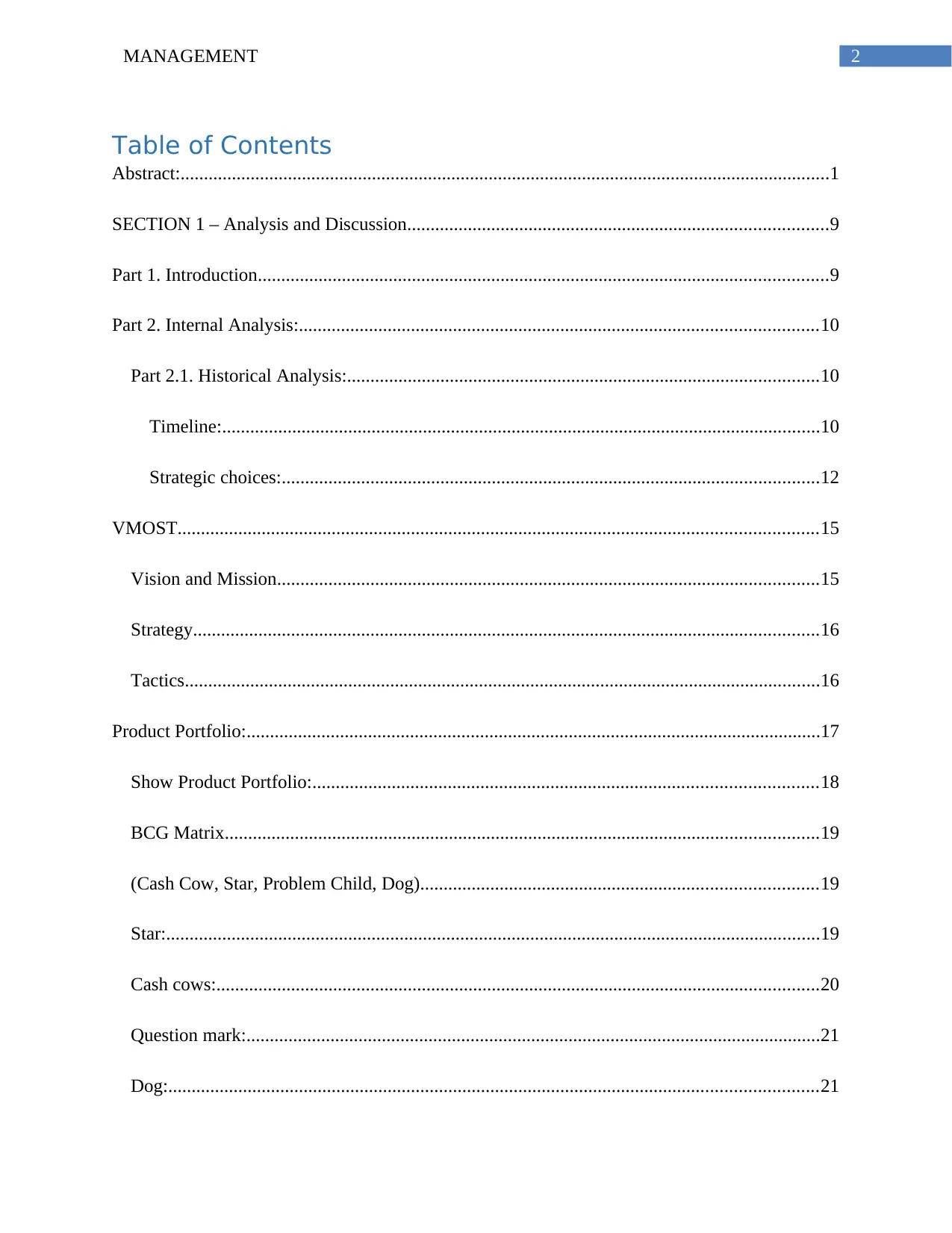
2MANAGEMENT
Table of Contents
Abstract:...........................................................................................................................................1
SECTION 1 – Analysis and Discussion..........................................................................................9
Part 1. Introduction..........................................................................................................................9
Part 2. Internal Analysis:...............................................................................................................10
Part 2.1. Historical Analysis:.....................................................................................................10
Timeline:................................................................................................................................10
Strategic choices:...................................................................................................................12
VMOST.........................................................................................................................................15
Vision and Mission....................................................................................................................15
Strategy......................................................................................................................................16
Tactics........................................................................................................................................16
Product Portfolio:...........................................................................................................................17
Show Product Portfolio:............................................................................................................18
BCG Matrix...............................................................................................................................19
(Cash Cow, Star, Problem Child, Dog).....................................................................................19
Star:............................................................................................................................................19
Cash cows:.................................................................................................................................20
Question mark:...........................................................................................................................21
Dog:...........................................................................................................................................21
Table of Contents
Abstract:...........................................................................................................................................1
SECTION 1 – Analysis and Discussion..........................................................................................9
Part 1. Introduction..........................................................................................................................9
Part 2. Internal Analysis:...............................................................................................................10
Part 2.1. Historical Analysis:.....................................................................................................10
Timeline:................................................................................................................................10
Strategic choices:...................................................................................................................12
VMOST.........................................................................................................................................15
Vision and Mission....................................................................................................................15
Strategy......................................................................................................................................16
Tactics........................................................................................................................................16
Product Portfolio:...........................................................................................................................17
Show Product Portfolio:............................................................................................................18
BCG Matrix...............................................................................................................................19
(Cash Cow, Star, Problem Child, Dog).....................................................................................19
Star:............................................................................................................................................19
Cash cows:.................................................................................................................................20
Question mark:...........................................................................................................................21
Dog:...........................................................................................................................................21
⊘ This is a preview!⊘
Do you want full access?
Subscribe today to unlock all pages.

Trusted by 1+ million students worldwide
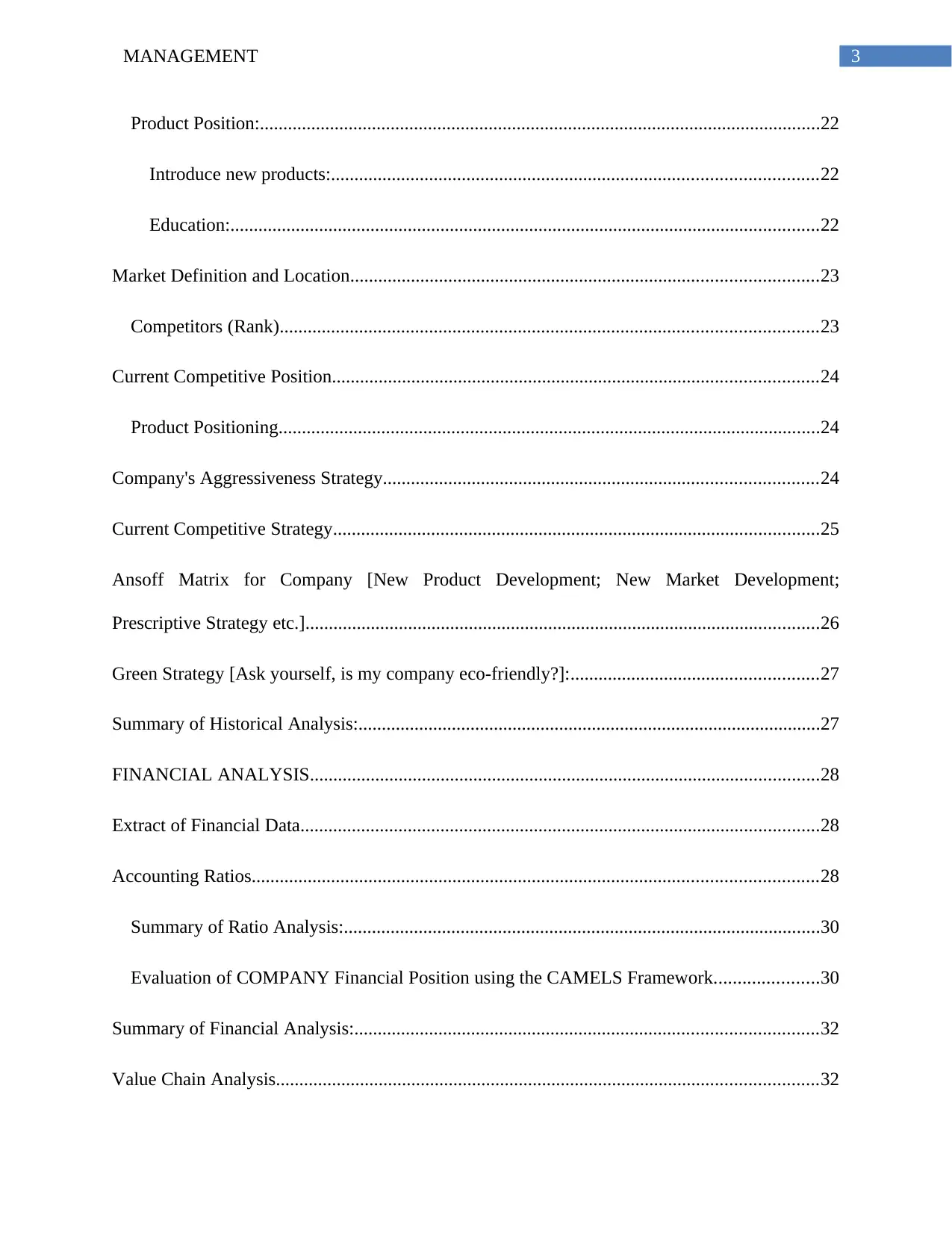
3MANAGEMENT
Product Position:........................................................................................................................22
Introduce new products:........................................................................................................22
Education:..............................................................................................................................22
Market Definition and Location....................................................................................................23
Competitors (Rank)...................................................................................................................23
Current Competitive Position........................................................................................................24
Product Positioning....................................................................................................................24
Company's Aggressiveness Strategy.............................................................................................24
Current Competitive Strategy........................................................................................................25
Ansoff Matrix for Company [New Product Development; New Market Development;
Prescriptive Strategy etc.]..............................................................................................................26
Green Strategy [Ask yourself, is my company eco-friendly?]:.....................................................27
Summary of Historical Analysis:...................................................................................................27
FINANCIAL ANALYSIS.............................................................................................................28
Extract of Financial Data...............................................................................................................28
Accounting Ratios.........................................................................................................................28
Summary of Ratio Analysis:......................................................................................................30
Evaluation of COMPANY Financial Position using the CAMELS Framework......................30
Summary of Financial Analysis:...................................................................................................32
Value Chain Analysis....................................................................................................................32
Product Position:........................................................................................................................22
Introduce new products:........................................................................................................22
Education:..............................................................................................................................22
Market Definition and Location....................................................................................................23
Competitors (Rank)...................................................................................................................23
Current Competitive Position........................................................................................................24
Product Positioning....................................................................................................................24
Company's Aggressiveness Strategy.............................................................................................24
Current Competitive Strategy........................................................................................................25
Ansoff Matrix for Company [New Product Development; New Market Development;
Prescriptive Strategy etc.]..............................................................................................................26
Green Strategy [Ask yourself, is my company eco-friendly?]:.....................................................27
Summary of Historical Analysis:...................................................................................................27
FINANCIAL ANALYSIS.............................................................................................................28
Extract of Financial Data...............................................................................................................28
Accounting Ratios.........................................................................................................................28
Summary of Ratio Analysis:......................................................................................................30
Evaluation of COMPANY Financial Position using the CAMELS Framework......................30
Summary of Financial Analysis:...................................................................................................32
Value Chain Analysis....................................................................................................................32
Paraphrase This Document
Need a fresh take? Get an instant paraphrase of this document with our AI Paraphraser
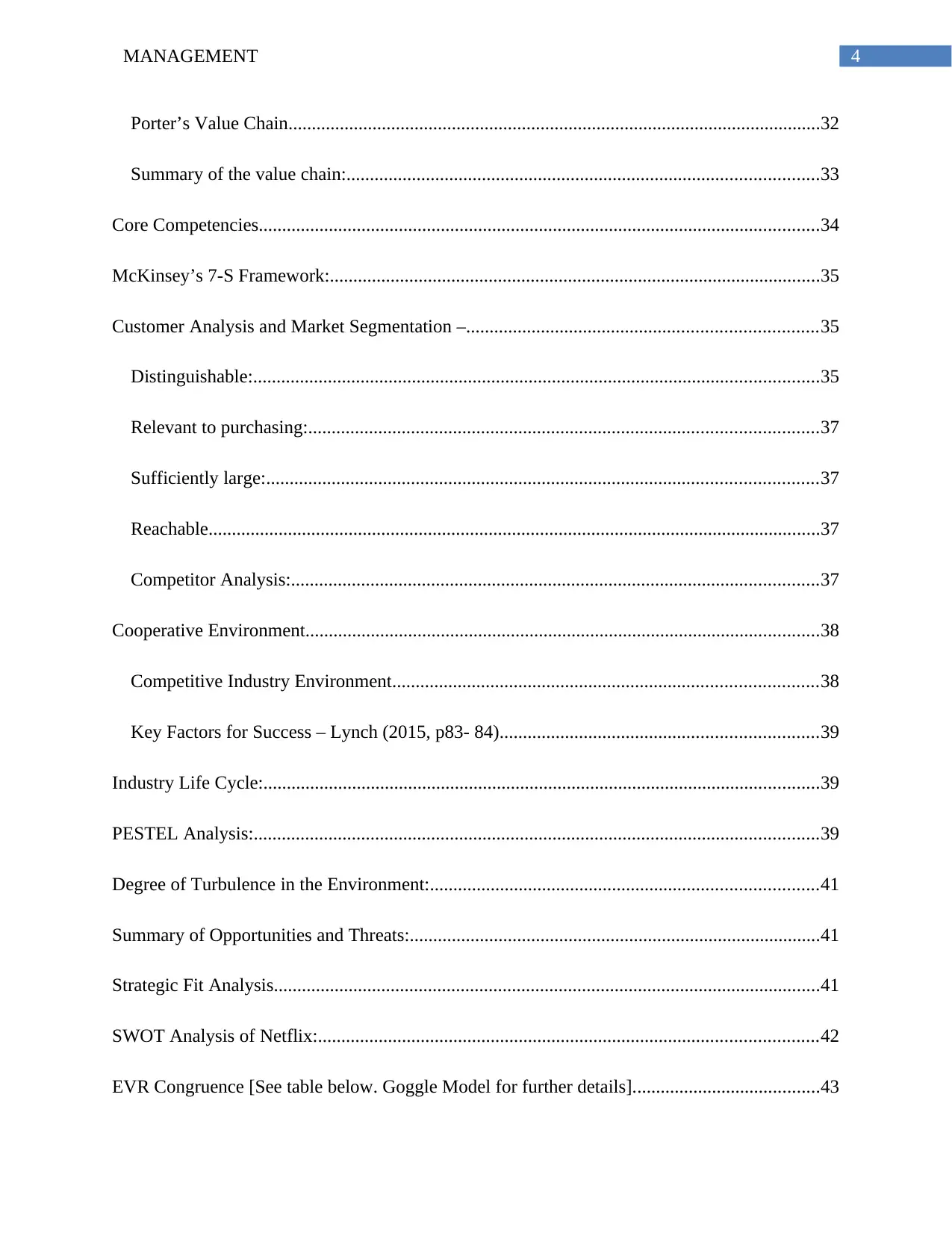
4MANAGEMENT
Porter’s Value Chain..................................................................................................................32
Summary of the value chain:.....................................................................................................33
Core Competencies........................................................................................................................34
McKinsey’s 7-S Framework:.........................................................................................................35
Customer Analysis and Market Segmentation –...........................................................................35
Distinguishable:.........................................................................................................................35
Relevant to purchasing:.............................................................................................................37
Sufficiently large:......................................................................................................................37
Reachable...................................................................................................................................37
Competitor Analysis:.................................................................................................................37
Cooperative Environment..............................................................................................................38
Competitive Industry Environment...........................................................................................38
Key Factors for Success – Lynch (2015, p83- 84)....................................................................39
Industry Life Cycle:.......................................................................................................................39
PESTEL Analysis:.........................................................................................................................39
Degree of Turbulence in the Environment:...................................................................................41
Summary of Opportunities and Threats:........................................................................................41
Strategic Fit Analysis.....................................................................................................................41
SWOT Analysis of Netflix:...........................................................................................................42
EVR Congruence [See table below. Goggle Model for further details]........................................43
Porter’s Value Chain..................................................................................................................32
Summary of the value chain:.....................................................................................................33
Core Competencies........................................................................................................................34
McKinsey’s 7-S Framework:.........................................................................................................35
Customer Analysis and Market Segmentation –...........................................................................35
Distinguishable:.........................................................................................................................35
Relevant to purchasing:.............................................................................................................37
Sufficiently large:......................................................................................................................37
Reachable...................................................................................................................................37
Competitor Analysis:.................................................................................................................37
Cooperative Environment..............................................................................................................38
Competitive Industry Environment...........................................................................................38
Key Factors for Success – Lynch (2015, p83- 84)....................................................................39
Industry Life Cycle:.......................................................................................................................39
PESTEL Analysis:.........................................................................................................................39
Degree of Turbulence in the Environment:...................................................................................41
Summary of Opportunities and Threats:........................................................................................41
Strategic Fit Analysis.....................................................................................................................41
SWOT Analysis of Netflix:...........................................................................................................42
EVR Congruence [See table below. Goggle Model for further details]........................................43
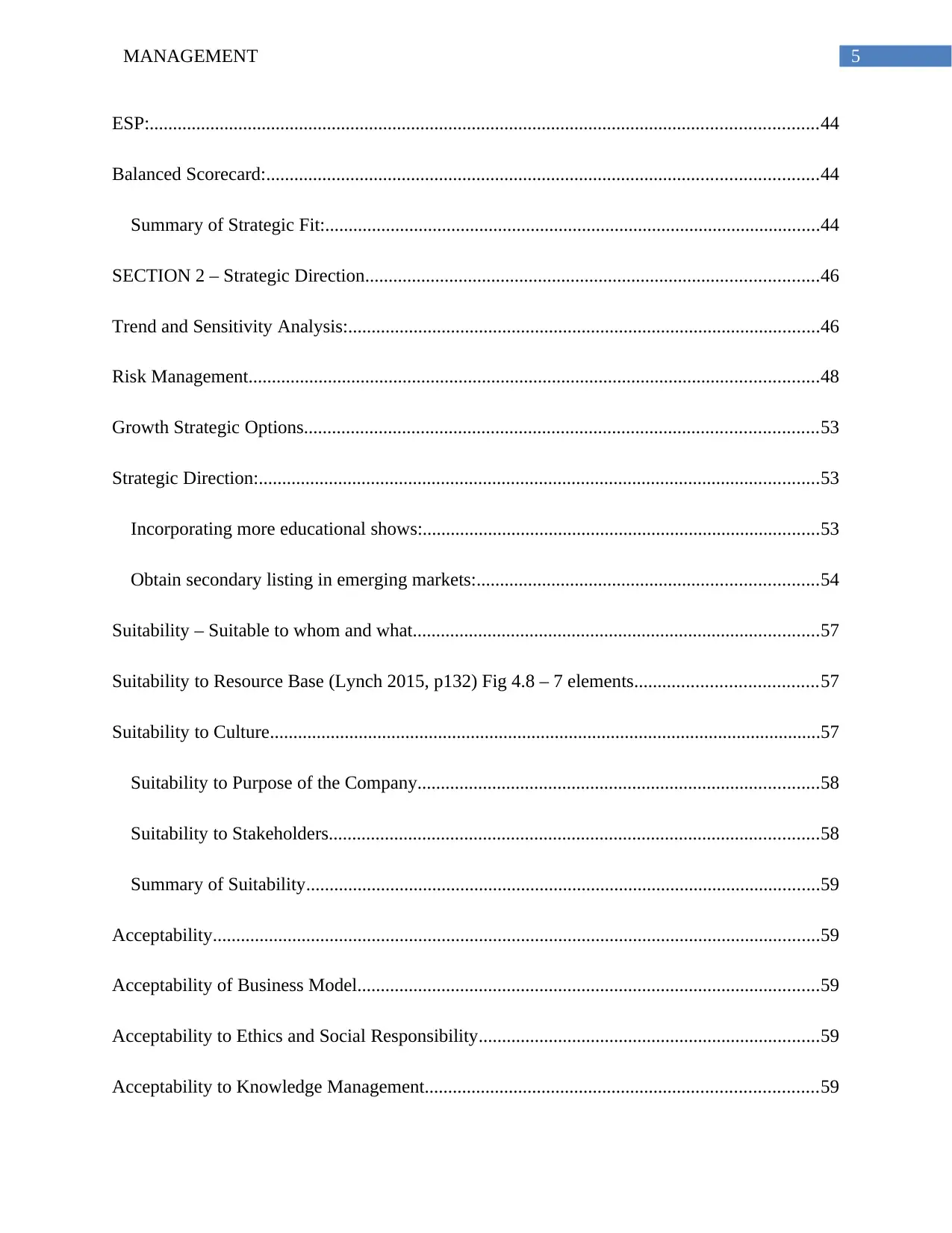
5MANAGEMENT
ESP:...............................................................................................................................................44
Balanced Scorecard:......................................................................................................................44
Summary of Strategic Fit:..........................................................................................................44
SECTION 2 – Strategic Direction.................................................................................................46
Trend and Sensitivity Analysis:.....................................................................................................46
Risk Management..........................................................................................................................48
Growth Strategic Options..............................................................................................................53
Strategic Direction:........................................................................................................................53
Incorporating more educational shows:.....................................................................................53
Obtain secondary listing in emerging markets:.........................................................................54
Suitability – Suitable to whom and what.......................................................................................57
Suitability to Resource Base (Lynch 2015, p132) Fig 4.8 – 7 elements.......................................57
Suitability to Culture......................................................................................................................57
Suitability to Purpose of the Company......................................................................................58
Suitability to Stakeholders.........................................................................................................58
Summary of Suitability..............................................................................................................59
Acceptability..................................................................................................................................59
Acceptability of Business Model...................................................................................................59
Acceptability to Ethics and Social Responsibility.........................................................................59
Acceptability to Knowledge Management....................................................................................59
ESP:...............................................................................................................................................44
Balanced Scorecard:......................................................................................................................44
Summary of Strategic Fit:..........................................................................................................44
SECTION 2 – Strategic Direction.................................................................................................46
Trend and Sensitivity Analysis:.....................................................................................................46
Risk Management..........................................................................................................................48
Growth Strategic Options..............................................................................................................53
Strategic Direction:........................................................................................................................53
Incorporating more educational shows:.....................................................................................53
Obtain secondary listing in emerging markets:.........................................................................54
Suitability – Suitable to whom and what.......................................................................................57
Suitability to Resource Base (Lynch 2015, p132) Fig 4.8 – 7 elements.......................................57
Suitability to Culture......................................................................................................................57
Suitability to Purpose of the Company......................................................................................58
Suitability to Stakeholders.........................................................................................................58
Summary of Suitability..............................................................................................................59
Acceptability..................................................................................................................................59
Acceptability of Business Model...................................................................................................59
Acceptability to Ethics and Social Responsibility.........................................................................59
Acceptability to Knowledge Management....................................................................................59
⊘ This is a preview!⊘
Do you want full access?
Subscribe today to unlock all pages.

Trusted by 1+ million students worldwide
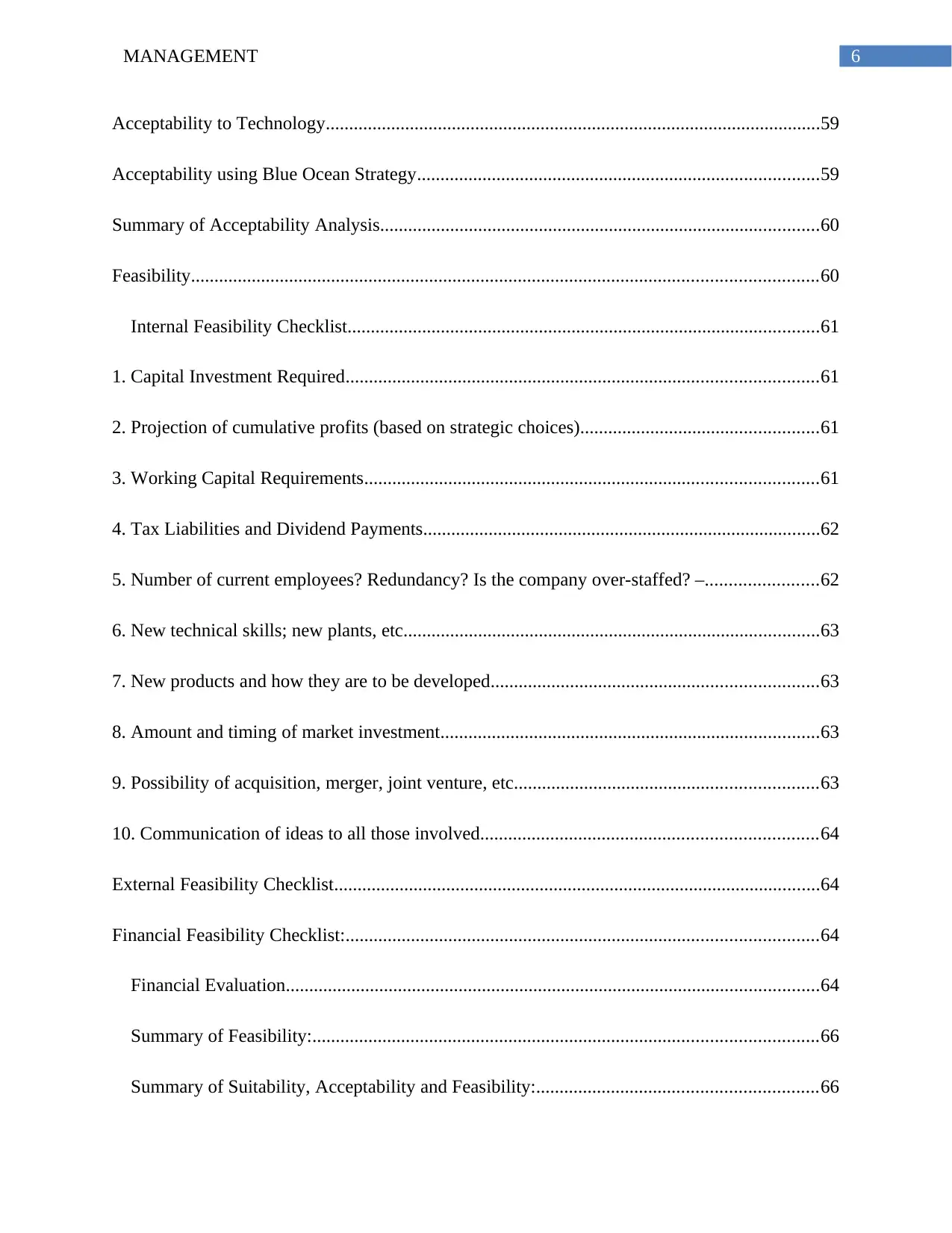
6MANAGEMENT
Acceptability to Technology..........................................................................................................59
Acceptability using Blue Ocean Strategy......................................................................................59
Summary of Acceptability Analysis..............................................................................................60
Feasibility......................................................................................................................................60
Internal Feasibility Checklist.....................................................................................................61
1. Capital Investment Required.....................................................................................................61
2. Projection of cumulative profits (based on strategic choices)...................................................61
3. Working Capital Requirements.................................................................................................61
4. Tax Liabilities and Dividend Payments.....................................................................................62
5. Number of current employees? Redundancy? Is the company over-staffed? –........................62
6. New technical skills; new plants, etc.........................................................................................63
7. New products and how they are to be developed......................................................................63
8. Amount and timing of market investment.................................................................................63
9. Possibility of acquisition, merger, joint venture, etc.................................................................63
10. Communication of ideas to all those involved........................................................................64
External Feasibility Checklist........................................................................................................64
Financial Feasibility Checklist:.....................................................................................................64
Financial Evaluation..................................................................................................................64
Summary of Feasibility:............................................................................................................66
Summary of Suitability, Acceptability and Feasibility:............................................................66
Acceptability to Technology..........................................................................................................59
Acceptability using Blue Ocean Strategy......................................................................................59
Summary of Acceptability Analysis..............................................................................................60
Feasibility......................................................................................................................................60
Internal Feasibility Checklist.....................................................................................................61
1. Capital Investment Required.....................................................................................................61
2. Projection of cumulative profits (based on strategic choices)...................................................61
3. Working Capital Requirements.................................................................................................61
4. Tax Liabilities and Dividend Payments.....................................................................................62
5. Number of current employees? Redundancy? Is the company over-staffed? –........................62
6. New technical skills; new plants, etc.........................................................................................63
7. New products and how they are to be developed......................................................................63
8. Amount and timing of market investment.................................................................................63
9. Possibility of acquisition, merger, joint venture, etc.................................................................63
10. Communication of ideas to all those involved........................................................................64
External Feasibility Checklist........................................................................................................64
Financial Feasibility Checklist:.....................................................................................................64
Financial Evaluation..................................................................................................................64
Summary of Feasibility:............................................................................................................66
Summary of Suitability, Acceptability and Feasibility:............................................................66
Paraphrase This Document
Need a fresh take? Get an instant paraphrase of this document with our AI Paraphraser
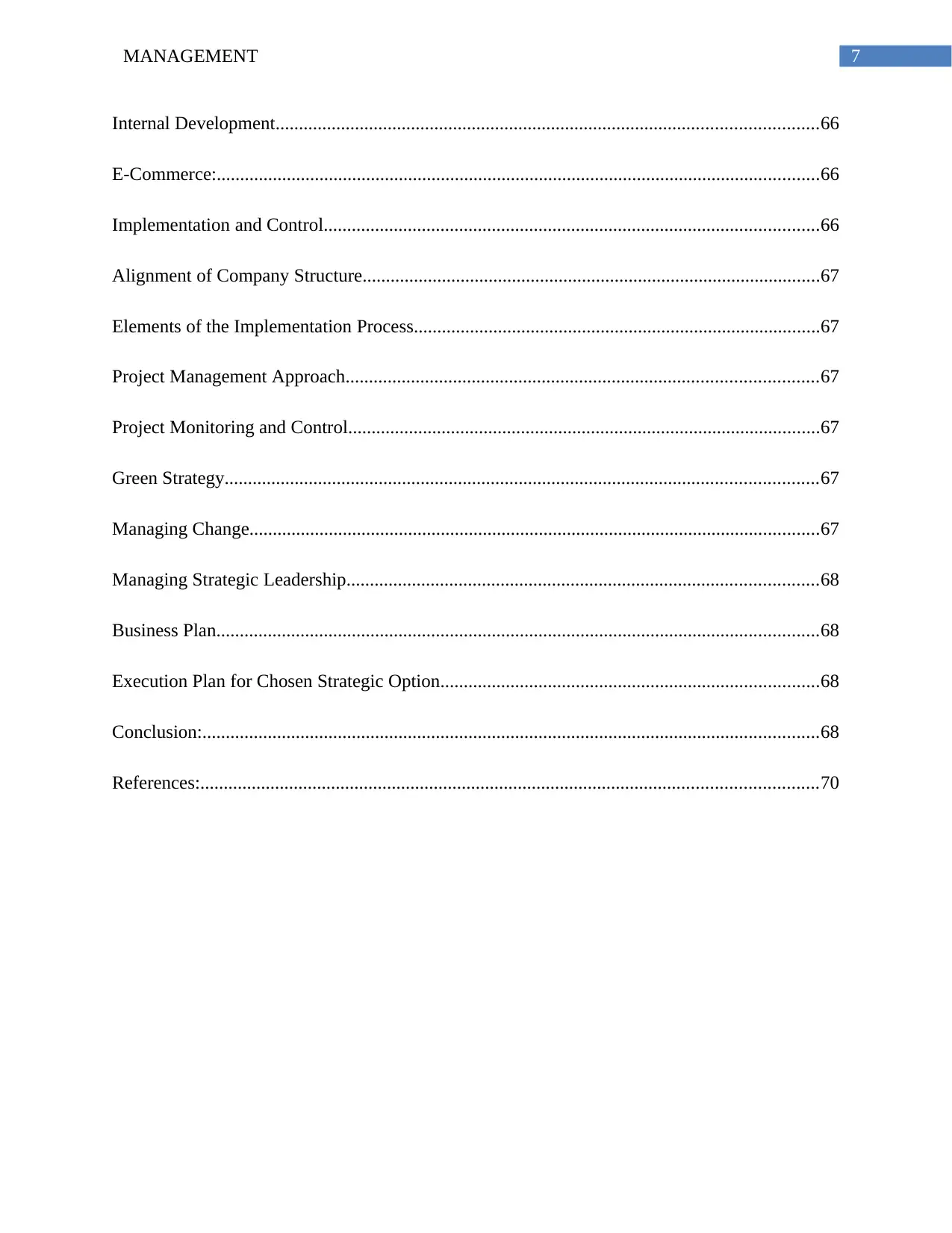
7MANAGEMENT
Internal Development....................................................................................................................66
E-Commerce:.................................................................................................................................66
Implementation and Control..........................................................................................................66
Alignment of Company Structure..................................................................................................67
Elements of the Implementation Process.......................................................................................67
Project Management Approach.....................................................................................................67
Project Monitoring and Control.....................................................................................................67
Green Strategy...............................................................................................................................67
Managing Change..........................................................................................................................67
Managing Strategic Leadership.....................................................................................................68
Business Plan.................................................................................................................................68
Execution Plan for Chosen Strategic Option.................................................................................68
Conclusion:....................................................................................................................................68
References:....................................................................................................................................70
Internal Development....................................................................................................................66
E-Commerce:.................................................................................................................................66
Implementation and Control..........................................................................................................66
Alignment of Company Structure..................................................................................................67
Elements of the Implementation Process.......................................................................................67
Project Management Approach.....................................................................................................67
Project Monitoring and Control.....................................................................................................67
Green Strategy...............................................................................................................................67
Managing Change..........................................................................................................................67
Managing Strategic Leadership.....................................................................................................68
Business Plan.................................................................................................................................68
Execution Plan for Chosen Strategic Option.................................................................................68
Conclusion:....................................................................................................................................68
References:....................................................................................................................................70
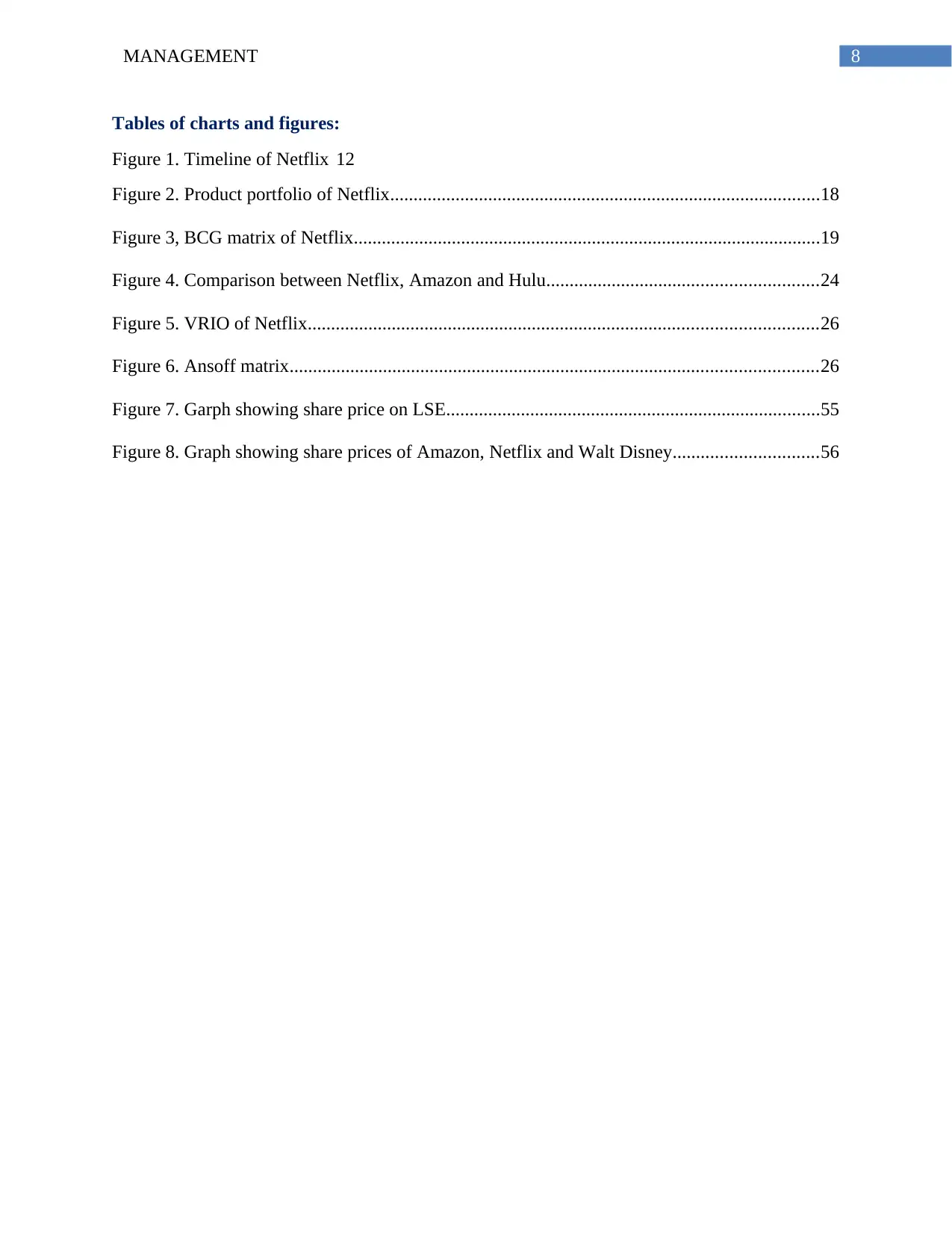
8MANAGEMENT
Tables of charts and figures:
Figure 1. Timeline of Netflix 12
Figure 2. Product portfolio of Netflix............................................................................................18
Figure 3, BCG matrix of Netflix....................................................................................................19
Figure 4. Comparison between Netflix, Amazon and Hulu..........................................................24
Figure 5. VRIO of Netflix.............................................................................................................26
Figure 6. Ansoff matrix.................................................................................................................26
Figure 7. Garph showing share price on LSE................................................................................55
Figure 8. Graph showing share prices of Amazon, Netflix and Walt Disney...............................56
Tables of charts and figures:
Figure 1. Timeline of Netflix 12
Figure 2. Product portfolio of Netflix............................................................................................18
Figure 3, BCG matrix of Netflix....................................................................................................19
Figure 4. Comparison between Netflix, Amazon and Hulu..........................................................24
Figure 5. VRIO of Netflix.............................................................................................................26
Figure 6. Ansoff matrix.................................................................................................................26
Figure 7. Garph showing share price on LSE................................................................................55
Figure 8. Graph showing share prices of Amazon, Netflix and Walt Disney...............................56
⊘ This is a preview!⊘
Do you want full access?
Subscribe today to unlock all pages.

Trusted by 1+ million students worldwide
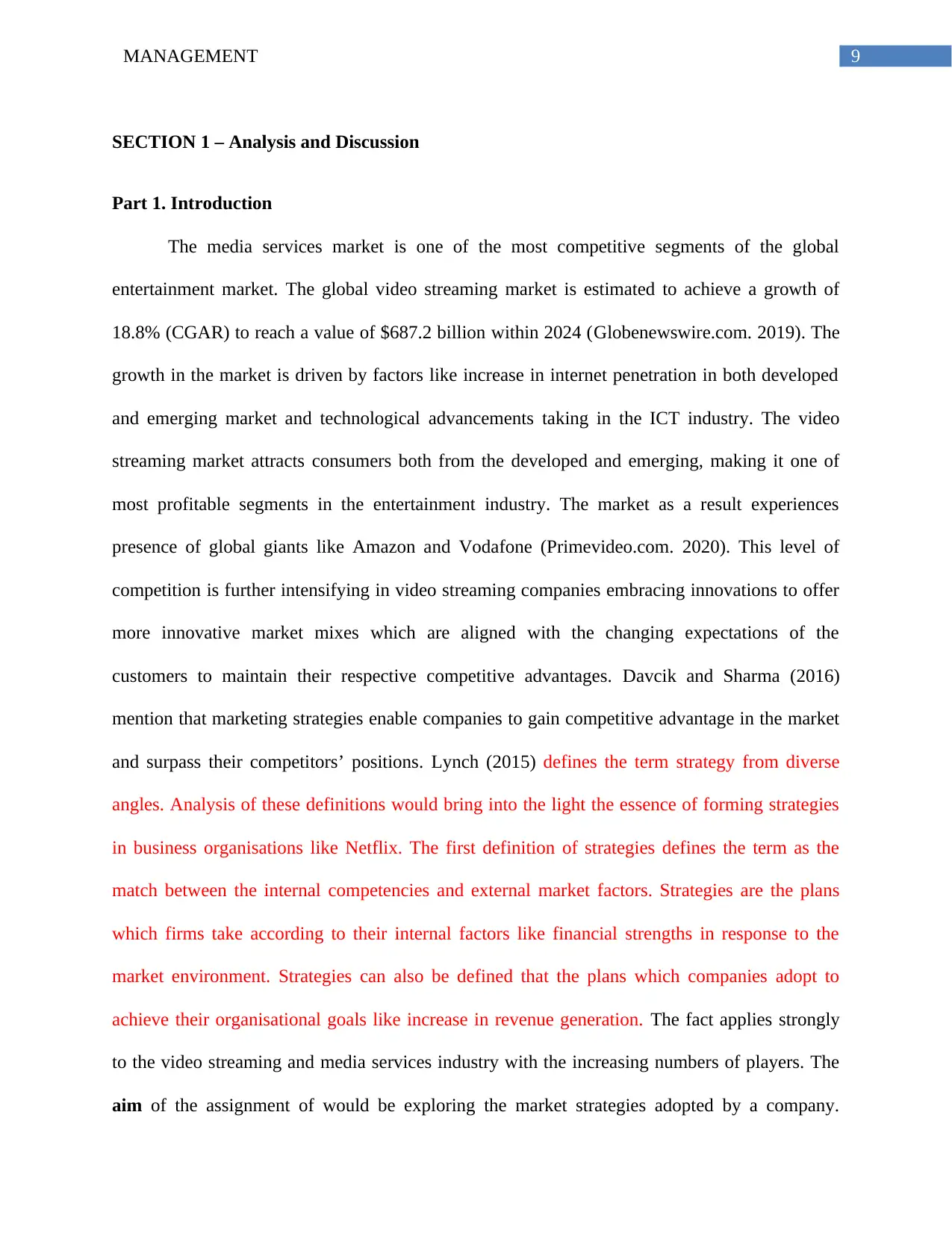
9MANAGEMENT
SECTION 1 – Analysis and Discussion
Part 1. Introduction
The media services market is one of the most competitive segments of the global
entertainment market. The global video streaming market is estimated to achieve a growth of
18.8% (CGAR) to reach a value of $687.2 billion within 2024 (Globenewswire.com. 2019). The
growth in the market is driven by factors like increase in internet penetration in both developed
and emerging market and technological advancements taking in the ICT industry. The video
streaming market attracts consumers both from the developed and emerging, making it one of
most profitable segments in the entertainment industry. The market as a result experiences
presence of global giants like Amazon and Vodafone (Primevideo.com. 2020). This level of
competition is further intensifying in video streaming companies embracing innovations to offer
more innovative market mixes which are aligned with the changing expectations of the
customers to maintain their respective competitive advantages. Davcik and Sharma (2016)
mention that marketing strategies enable companies to gain competitive advantage in the market
and surpass their competitors’ positions. Lynch (2015) defines the term strategy from diverse
angles. Analysis of these definitions would bring into the light the essence of forming strategies
in business organisations like Netflix. The first definition of strategies defines the term as the
match between the internal competencies and external market factors. Strategies are the plans
which firms take according to their internal factors like financial strengths in response to the
market environment. Strategies can also be defined that the plans which companies adopt to
achieve their organisational goals like increase in revenue generation. The fact applies strongly
to the video streaming and media services industry with the increasing numbers of players. The
aim of the assignment of would be exploring the market strategies adopted by a company.
SECTION 1 – Analysis and Discussion
Part 1. Introduction
The media services market is one of the most competitive segments of the global
entertainment market. The global video streaming market is estimated to achieve a growth of
18.8% (CGAR) to reach a value of $687.2 billion within 2024 (Globenewswire.com. 2019). The
growth in the market is driven by factors like increase in internet penetration in both developed
and emerging market and technological advancements taking in the ICT industry. The video
streaming market attracts consumers both from the developed and emerging, making it one of
most profitable segments in the entertainment industry. The market as a result experiences
presence of global giants like Amazon and Vodafone (Primevideo.com. 2020). This level of
competition is further intensifying in video streaming companies embracing innovations to offer
more innovative market mixes which are aligned with the changing expectations of the
customers to maintain their respective competitive advantages. Davcik and Sharma (2016)
mention that marketing strategies enable companies to gain competitive advantage in the market
and surpass their competitors’ positions. Lynch (2015) defines the term strategy from diverse
angles. Analysis of these definitions would bring into the light the essence of forming strategies
in business organisations like Netflix. The first definition of strategies defines the term as the
match between the internal competencies and external market factors. Strategies are the plans
which firms take according to their internal factors like financial strengths in response to the
market environment. Strategies can also be defined that the plans which companies adopt to
achieve their organisational goals like increase in revenue generation. The fact applies strongly
to the video streaming and media services industry with the increasing numbers of players. The
aim of the assignment of would be exploring the market strategies adopted by a company.
Paraphrase This Document
Need a fresh take? Get an instant paraphrase of this document with our AI Paraphraser
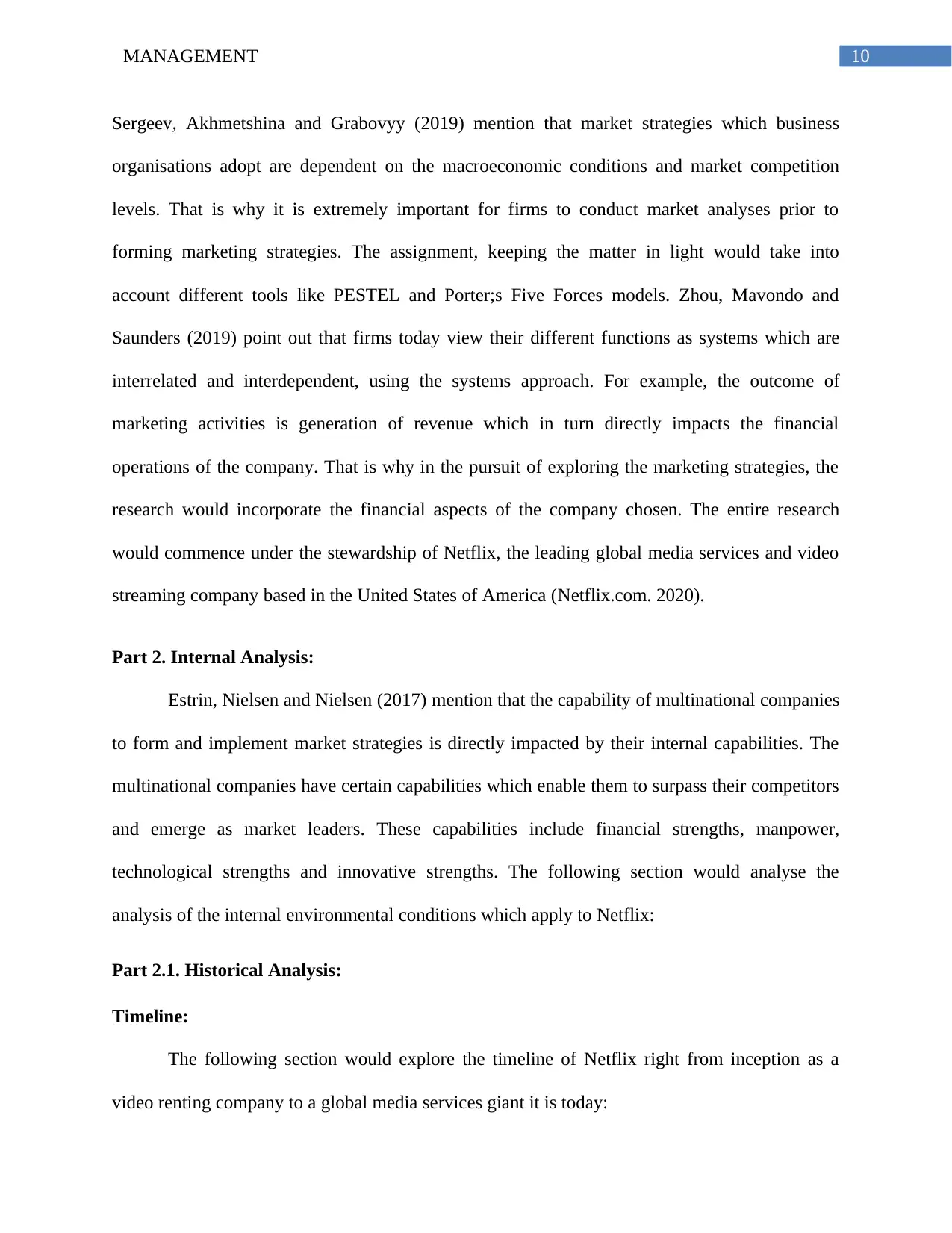
10MANAGEMENT
Sergeev, Akhmetshina and Grabovyy (2019) mention that market strategies which business
organisations adopt are dependent on the macroeconomic conditions and market competition
levels. That is why it is extremely important for firms to conduct market analyses prior to
forming marketing strategies. The assignment, keeping the matter in light would take into
account different tools like PESTEL and Porter;s Five Forces models. Zhou, Mavondo and
Saunders (2019) point out that firms today view their different functions as systems which are
interrelated and interdependent, using the systems approach. For example, the outcome of
marketing activities is generation of revenue which in turn directly impacts the financial
operations of the company. That is why in the pursuit of exploring the marketing strategies, the
research would incorporate the financial aspects of the company chosen. The entire research
would commence under the stewardship of Netflix, the leading global media services and video
streaming company based in the United States of America (Netflix.com. 2020).
Part 2. Internal Analysis:
Estrin, Nielsen and Nielsen (2017) mention that the capability of multinational companies
to form and implement market strategies is directly impacted by their internal capabilities. The
multinational companies have certain capabilities which enable them to surpass their competitors
and emerge as market leaders. These capabilities include financial strengths, manpower,
technological strengths and innovative strengths. The following section would analyse the
analysis of the internal environmental conditions which apply to Netflix:
Part 2.1. Historical Analysis:
Timeline:
The following section would explore the timeline of Netflix right from inception as a
video renting company to a global media services giant it is today:
Sergeev, Akhmetshina and Grabovyy (2019) mention that market strategies which business
organisations adopt are dependent on the macroeconomic conditions and market competition
levels. That is why it is extremely important for firms to conduct market analyses prior to
forming marketing strategies. The assignment, keeping the matter in light would take into
account different tools like PESTEL and Porter;s Five Forces models. Zhou, Mavondo and
Saunders (2019) point out that firms today view their different functions as systems which are
interrelated and interdependent, using the systems approach. For example, the outcome of
marketing activities is generation of revenue which in turn directly impacts the financial
operations of the company. That is why in the pursuit of exploring the marketing strategies, the
research would incorporate the financial aspects of the company chosen. The entire research
would commence under the stewardship of Netflix, the leading global media services and video
streaming company based in the United States of America (Netflix.com. 2020).
Part 2. Internal Analysis:
Estrin, Nielsen and Nielsen (2017) mention that the capability of multinational companies
to form and implement market strategies is directly impacted by their internal capabilities. The
multinational companies have certain capabilities which enable them to surpass their competitors
and emerge as market leaders. These capabilities include financial strengths, manpower,
technological strengths and innovative strengths. The following section would analyse the
analysis of the internal environmental conditions which apply to Netflix:
Part 2.1. Historical Analysis:
Timeline:
The following section would explore the timeline of Netflix right from inception as a
video renting company to a global media services giant it is today:
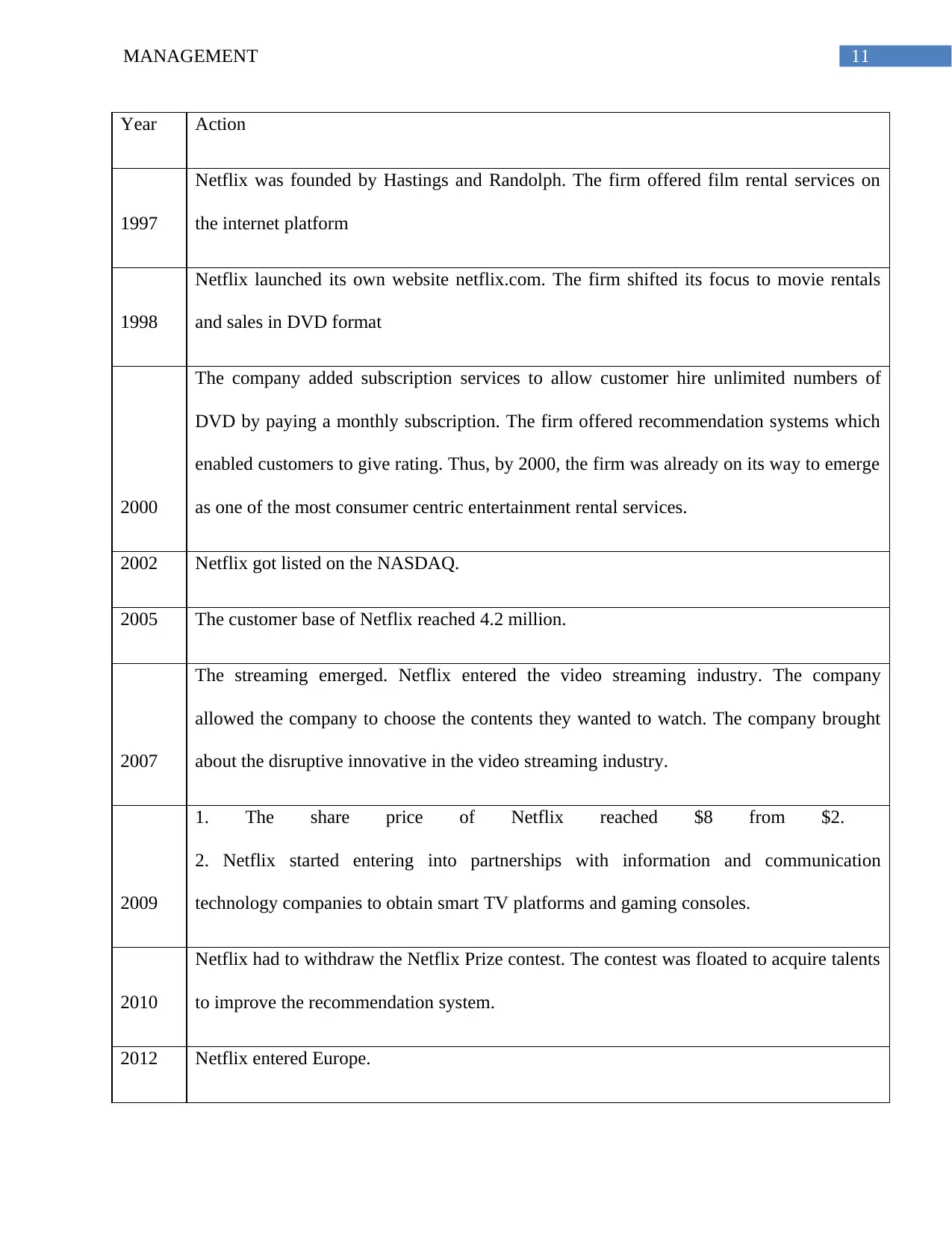
11MANAGEMENT
Year Action
1997
Netflix was founded by Hastings and Randolph. The firm offered film rental services on
the internet platform
1998
Netflix launched its own website netflix.com. The firm shifted its focus to movie rentals
and sales in DVD format
2000
The company added subscription services to allow customer hire unlimited numbers of
DVD by paying a monthly subscription. The firm offered recommendation systems which
enabled customers to give rating. Thus, by 2000, the firm was already on its way to emerge
as one of the most consumer centric entertainment rental services.
2002 Netflix got listed on the NASDAQ.
2005 The customer base of Netflix reached 4.2 million.
2007
The streaming emerged. Netflix entered the video streaming industry. The company
allowed the company to choose the contents they wanted to watch. The company brought
about the disruptive innovative in the video streaming industry.
2009
1. The share price of Netflix reached $8 from $2.
2. Netflix started entering into partnerships with information and communication
technology companies to obtain smart TV platforms and gaming consoles.
2010
Netflix had to withdraw the Netflix Prize contest. The contest was floated to acquire talents
to improve the recommendation system.
2012 Netflix entered Europe.
Year Action
1997
Netflix was founded by Hastings and Randolph. The firm offered film rental services on
the internet platform
1998
Netflix launched its own website netflix.com. The firm shifted its focus to movie rentals
and sales in DVD format
2000
The company added subscription services to allow customer hire unlimited numbers of
DVD by paying a monthly subscription. The firm offered recommendation systems which
enabled customers to give rating. Thus, by 2000, the firm was already on its way to emerge
as one of the most consumer centric entertainment rental services.
2002 Netflix got listed on the NASDAQ.
2005 The customer base of Netflix reached 4.2 million.
2007
The streaming emerged. Netflix entered the video streaming industry. The company
allowed the company to choose the contents they wanted to watch. The company brought
about the disruptive innovative in the video streaming industry.
2009
1. The share price of Netflix reached $8 from $2.
2. Netflix started entering into partnerships with information and communication
technology companies to obtain smart TV platforms and gaming consoles.
2010
Netflix had to withdraw the Netflix Prize contest. The contest was floated to acquire talents
to improve the recommendation system.
2012 Netflix entered Europe.
⊘ This is a preview!⊘
Do you want full access?
Subscribe today to unlock all pages.

Trusted by 1+ million students worldwide
1 out of 74
Related Documents
Your All-in-One AI-Powered Toolkit for Academic Success.
+13062052269
info@desklib.com
Available 24*7 on WhatsApp / Email
![[object Object]](/_next/static/media/star-bottom.7253800d.svg)
Unlock your academic potential
Copyright © 2020–2025 A2Z Services. All Rights Reserved. Developed and managed by ZUCOL.





